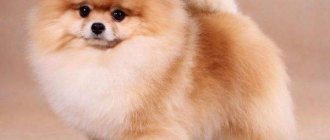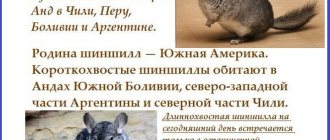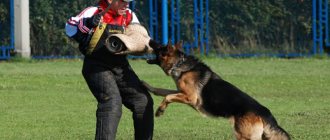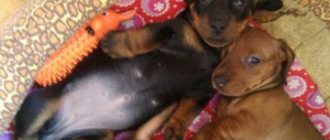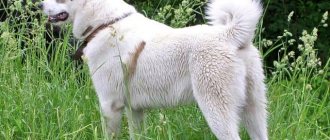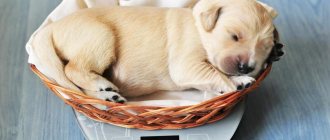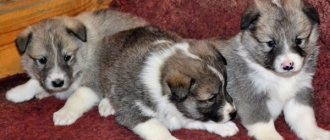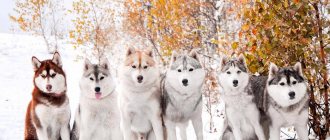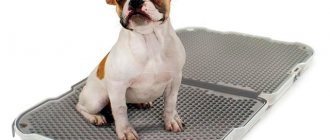Laika is recognized as one of the best hunting breeds
The Laika is recognized as one of the best hunting breeds for its balanced character and stern appearance. Since ancient times, the ancestors of this breed lived in the Urals and Siberia, thereby tempering their character in harsh taiga conditions, where the strongest survived. Today the Laika is very popular in Russia. This is a guard dog with an excellent sense of smell, excessive activity and excitement when tracking an animal. The color varies; the face bears a certain resemblance to a wolf. Character and appearance are inherited from their ancestors: developed muscles, excellent health, sensitive sense of smell. If you want to have such a breed, you should evaluate all the pros and cons.
Breed characteristics
The photo shows what West Siberian huskies look like:
Origin
Unfortunately, the exact origin of the breed is unknown. According to one version, the ancestors of the first WSLs were taiga wolves of the Khanty-Mansi Autonomous Okrug, which, as a result of selective selection and crossing, acquired loyalty to humans without losing their hunting qualities. Other sources talk about aboriginal Laikas in Western Siberia. The breed of West Siberian huskies owes its breeding directly to Joseph Vissarionovich Stalin, who issued the corresponding order. The first breed standard was approved in 1949. Still in force today with a single amendment from 1952. In 1980, the West Siberian Laika breed was officially recognized by international cynological organizations.
General characteristics of the West Siberian Laika breed
West Siberian Laikas are considered the best hunting dogs all over the world. They have good hearing and vision, a lot of perseverance and passion. They are hardy and adapted to the harsh climatic conditions of Siberia. These dogs are versatile and are used for hunting small and large animals.
They can be guards and watchmen, although they do not show aggression towards people at all; they are even friendly towards strangers. Thanks to its balanced character, loyalty and intelligence, the breed is popular as a companion.
| Options | Characteristic |
| breed name | West Siberian Laika, for short – ZSL |
| a country | USSR |
| breed group | Spitz and primitive type breeds, northern hunting dogs section |
| application | universal hunter, companion |
| character traits | hardy, sociable, reasonable, independent, balanced, devoted |
| life expectancy | 10-14 years |
| height | males 55-62 cm, females 51-58 cm |
| weight | 16-22 kg |
| aggression | low |
| activity | high |
| intelligence | standard |
| security qualities | average |
| attitude towards a person | friendly, love children |
| care | easy, but they shed a lot |
| health | good, strong immunity |
pros
The West Siberian Laika is quite popular all over the world. This is a hardy and passionate working dog. It has many advantages:
- This is a universal hunter;
- devoted companion;
- does not show aggression towards humans at all;
- good-natured, loves children;
- clean, wool does not smell;
- has an attractive appearance;
- unpretentious, not picky about food;
- has good health and can easily withstand any weather conditions.
Minuses
This breed is not suitable for inexperienced dog owners or those who are used to working dogs. Laika will not obey unquestioningly; she is independent, can be stubborn, even uncontrollable. But at the same time, it is highly dependent on the person and requires constant attention and communication. These dogs have a few more disadvantages:
- can be aggressive towards other animals and see them as objects for hunting;
- cannot stand loneliness;
- out of boredom they can chew furniture and things in the house;
- They need active walking and a lot of physical activity.
The video complements the characteristics of the breed:
Video: West Siberian Laika.
Video: West Siberian Laika - all about the dog breed
Video: West Siberian Laika. Peculiarities. Care
Photo gallery
Let's look at photographs of these freedom-loving dogs, who are accustomed to running for many kilometers and require space when keeping them. But nevertheless, a comfortable existence of these animals is possible even in urban conditions.
Description of appearance
Externally, the West Siberian Laika resembles a wolf. They have a harmoniously built powerful rectangular body. Sexual dimorphism is clearly expressed: males are much larger and rougher than females. Their height at the withers is 62 cm, there are individuals up to 69 cm, females grow no higher than 58 cm. But the physique is lean, with developed muscles. Despite the fact that they are medium-sized dogs, they weigh on average 16-20 kg.
Head
The head is triangular in shape, proportional to the body. The skull is narrow, rounded, with a pronounced occipital protuberance. The forehead is flat, the brow ridges and stops are almost invisible. The muzzle is elongated, wedge-shaped. The jaws are powerful, the teeth are strong, the bite is scissor-shaped. The cheekbones are flat, the lips are dry, tight-fitting, and black.
The bridge of the nose is straight, the lobe is large, black. In white individuals it may be brownish, but it is always well pigmented. The eyes are medium in size, set slightly obliquely and deeply. The iris is dark brown. The look is attentive, intelligent, expressive. The ears are triangular, erect, and set high.
Frame
The neck is elongated and muscular. The withers are prominent, the back is wide and straight. The loin is short, convex, the croup is sloping and wide. The height at the withers is 1-2 cm greater than at the rump. The chest is quite deep and wide. The Khanty variety is more voluminous. The stomach is slightly tucked. The tail is set high, long, and well covered with hair. Usually twisted into a steering wheel and thrown over the lower back or to the side.
Limbs
The forelimbs are straight and long. The length is half the height of the dog at the withers. Set wide apart, parallel. The shoulder blades are long, the elbows are pressed to the body, directed back. The hind limbs are slightly shorter than the forelimbs. They are muscular, their thighs are long and strong. The paws are oval, the toes are collected. The middle finger is slightly longer than the others. The dog moves easily, freely, at a trot, which when running turns into a gallop.
Coat and color
The West Siberian Laika has a double, thick coat. The outer hair is straight, hard, and of medium length. It is especially thick on the shoulders and neck – it forms a collar. There are fluffy pants on the hind legs, and there is long hair between the toes. On the head and front surface of the legs, the hair is shorter and lies tightly to the body. The undercoat is thick, fluffy and soft, and protects the dog well from all weather conditions.
Colors may vary. The standard allows red, gray, white colors and their combinations. The following colors are common:
- zonally piebald;
- red with white spots;
- wolfish;
- deer;
- red-brown;
- pale yellow;
- white with gray or red spots.
Photos complement the description of the appearance of these dogs:
Disqualifying Faults
This is a factory breed, but the standard was created on the basis of already existing breed characteristics of huskies and changed slightly. Any deviation from his requirements leads to the disqualification of the dog. The most common disadvantages are:
- malocclusion;
- drooping ears;
- saber or straight tail;
- unacceptable colors: brindle, black, chocolate;
- light eyes;
- flat chest;
- sudden stop;
- weakly defined undercoat;
- sagging back;
- clubfoot, unnatural gait;
- too short or long coat.
Pedigree varieties
Until now, experts distinguish two breed varieties: Khanty and Mansi. The differences between them are minor. The Khanty Laika is more adapted to cold climates. She has a squat build, a shorter muzzle, narrower eyes, and smaller ears. The coat is thick, with erect hair, and the undercoat is abundant.
The Mansi Laika is tall-legged and graceful. It is more suitable for working in dense taiga. She has an elongated pointed muzzle, large ears, round eyes, and close-fitting fur.
Video
The most suitable habitat for these dogs near humans is an enclosure. In the video, an experienced dog specialist will share the secrets of keeping puppies. Enjoy watching!
Laikas come from Eastern and Western Siberia. This breed was bred in the harsh conditions of the Siberian Arctic seas, where it was used for herding animals and transporting goods over long distances in frozen tundra conditions. As fur traders made their way to Alaska in the early 20th century, they used Siberian huskies on these passages.
This breed was successfully used to transport valuable medicines to Alaska. During Admiral Peary's Antarctic expeditions, these dogs pulled sleds with equipment. During World War II they were involved in rescue operations in Arctic regions.
Character traits
Laika is a hunting breed, and many character traits are associated with this. Behavior and temperament resemble those of a wolf, making it a difficult dog to keep. Despite the fact that she is dependent on the attention of her owner, she often obeys her instincts and does not obey unquestioningly.
The main purpose of the husky's life is hunting. She needs to track down prey, chase animals, run, and get to know new places. Therefore, the breed is suitable only for hunters, athletes, and travelers. You should not have her as a companion for a person leading a sedentary lifestyle.
These dogs are very active, curious, playful, and talkative. This can create problems when kept in a city apartment. The dog needs space and constant attention. Out of boredom, she can chew furniture and ruin things. And the neighbors will not like the loud barking with which she will entertain herself.
West Siberian Laikas treat all people kindly. They can be taught to guard the territory, they are vigilant, and have good hearing. They are capable of driving away strangers with a loud bark, but no more. They never show aggression towards a person. They are affectionate and friendly with the owner. Despite their independent nature, they are not prone to dominance. Children are treated patronizingly, never offended, and pranks are tolerated. They love to play, but will not obey. For them, a child is not an authority, but a weak creature who needs to be looked after.
Huskies are intolerant of other animals. They often come into conflict with dogs. Small animals are hunted. They will only tolerate the pets they grew up with, but they will never become friends with them. Other animals are perceived as prey.
Representatives of this breed are characterized by the following character traits:
- friendliness;
- curiosity;
- independence;
- sociability;
- cheerfulness;
- mobility;
- devotion;
- gambling;
- courage;
- performance.
Education and training
Before training a husky, you need to keep in mind that this is not a service dog. Drilling, constantly practicing the same commands, or learning acrobatic tricks will not suit her. This is a hunter - strong, merciless and resilient. Therefore, you need to study the rules of behavior and commands to the minimum extent required so that keeping a dog does not cause problems.
It is recommended to start training a husky from an early age. It is necessary to teach how to respond to a nickname, know your place, and feeding schedule. It is obligatory to practice prohibitive commands. If the dog does not respond to “no”, “stay” and does not come to me the first time on the command “come to me”, you should not let it off the leash on the street. A Laika can chase a cat, a pigeon, or follow a scent that interests it and get lost.
These dogs are smart, quick-witted, but often stubborn and headstrong. Therefore, it is difficult to train them; a beginner may not be able to cope. In order for the pet’s training process to bring the right results, you need to take into account the character traits and follow the advice of dog handlers:
- you need to build a partnership with the dog;
- organize classes in such a way as to interest the pet; huskies quickly lose interest in learning;
- training should be short so that the puppy does not become overtired;
- give commands in a firm voice, but do not shout;
- You cannot use physical punishment or be rude - huskies are very touchy.
It is better to exercise with your pet at dog parks. Laikas have a strong competitive instinct, so they work better in a team. It is recommended to take a General training course under the guidance of a dog handler. Only after this can you practice your hunting skills.
Hunting with West Siberian Laika
The West Siberian Laika is a born hunter. With it you can hunt small and large animals: squirrels, fur-bearing and burrowing animals, roe deer, birds, wild boars and even bears. She is helped in this by her innate keen instincts, endurance, perseverance, and ringing bark. These dogs are well oriented in the area, easily find the scent of prey, and are able to work even on an old scent. But for a husky to become a successful hunter, it must be properly trained and regularly taken out hunting.
Already at 5-6 months, the puppy should begin to be introduced to the forest and new smells. From 10 months you can begin to practice working with the animal. If you don’t teach your pet to hunt in natural conditions before the age of two, then training him will be useless. The dog will only chase the neighbors' cats.
Pet health
ZSL is one of the healthiest pets that can easily survive any weather conditions. Laikas have a strong immune system and do not suffer from various types of genetic diseases. The life expectancy of representatives of this breed is 10–12 years.
The West Siberian Laika is a working breed of dog to which strict requirements were applied. Weak pets, unable to perform their duties, were weeded out and not allowed for further selection.
Maintenance and care
West Siberian Laikas are unpretentious dogs; they easily adapt to life in any conditions. They just don’t like cities, they need space and nature. It is best to keep a dog in a private house with a large plot. She can live in an enclosure with an insulated booth all year round.
But you cannot put this dog on a chain or put it in an enclosure and forget about it. Laikas require communication with their owner, space and physical activity. Even when kept in such conditions, they need to be walked 2-3 times a day. The walk should be at least an hour, with outdoor games and running. If your dog doesn't get enough exercise, he will get bored, become depressed, and begin to gain weight.
Hygiene
ZSL are unpretentious dogs. They are clean and do not need frequent washing. In summer, swimming in open water is enough; in winter, you can clean the wool with snow. It is recommended to bathe in a bath with shampoo no more than 2-3 times a year. The coat and undercoat are very difficult to get wet, as they are protected from water. The shampoo is difficult to wash out. After bathing, the dog takes a very long time to dry. Therefore, it is recommended to wash it only if absolutely necessary.
Once a week you will need to comb the coat with a wide-tooth comb to prevent tangles from forming. During the molting period in spring and autumn, this should be done daily. In addition to the comb, you will also need a furminator, a slicker, and a tangle cutter.
These dogs don’t need to brush their teeth, just give them chewy treats. But with inappropriate nutrition, they can lose their whiteness. To remove plaque, you need to use veterinary paste. Claws also usually wear down on their own during normal physical activity. You will need to regularly carry out the following hygiene procedures:
- wash paws after walks;
- after trips to nature, comb out blades of grass and debris from wool;
- inspect the paw pads, if wounds and cracks appear, lubricate them with healing cream;
- Examine eyes and ears regularly, for captive animals - every day.
If the dog lives in an enclosure, you need to change the straw bedding or wash the bed every week. The enclosure must be disinfected monthly and cleaned every day.
Nutrition
West Siberian huskies are not picky eaters. But to replenish the energy spent, they need a lot of protein. Meat should be given raw or scalded with boiling water. It should be lean. Trimmings, cartilage, sinews, and offal are suitable. You can diversify your dog's diet with cereals and seasonal vegetables. It is useful to give fermented milk products and greens. Natural feeding requires vitamin supplements.
You can feed your pet dry food. But it must be at least premium, high in protein and without artificial additives. Ideally, these are special foods for active hunting dogs:
- Bozita Robur Performance;
- HUBERT;
- Eukanuba;
- Grandorf;
- Canagan;
- Pro Plan;
- Brit Premium;
- GO!
After a year, you need to feed your dog 1-2 times a day, always after a walk. It is not recommended to feed before hunting. The bowl should be placed on a stand to maintain posture. Water should always be freely available.
Health
West Siberian huskies have been formed over centuries through natural selection. The strongest and most resilient individuals remained. Therefore, these dogs have excellent immunity and almost no hereditary diseases. Their only problems are injuries, snake or predator bites, and parasite infestation. Therefore, pets need to be vaccinated and dewormed in a timely manner, and their fur regularly treated for fleas and ticks.
Laikas that live indoors and move little may develop pathologies such as obesity, joint diseases, and disruption of the cardiovascular system. And due to poor nutrition, skin diseases may develop and hair will begin to fall out.
Training for hunting
Laikas have a hunting instinct from birth. The owner's task is to help the dog discover its talents.
When hunting elk, speed and the ability to dodge blows are important. It is better to train a dog in early spring or autumn, when it is cold but there is no snow. Ideally, it is better to take a hunting husky to a mountainous area, where the dog can move easily, unlike a hoofed animal.
It is better to choose a weaker animal, so that it is easier for an inexperienced dog. It is recommended to kill the first victim, and praise the dog and feed it well.
Bear
Bear hunting can begin when the husky turns 2 years old. Ideally, you should first show the dog a dead animal and watch the reaction. If the dog gets scared and starts to run away, you should not train it. If the acquaintance went well, the hunting husky is accustomed to the smell, showing bear tracks and places of bedding.
When hunting for large animals, you should use only powerful and nimble huskies - if the dog fails to avoid a blow, the result can be disastrous.
Boar
Hunting a wild boar is dangerous because it can rip open a dog with its fangs. Therefore, it is better to carry out training in an enclosure, where the owner is able to control the behavior of both the hunting dog and the pig. It is good if the pet stays within 5 meters of the victim. When dealing with a boar, courage and perseverance are important.
The dog must run away, not allowing itself to be wounded, and then again press the animal, notifying the owner by barking.
Squirrel
It is better to start learning to hunt with training on a squirrel. When chasing this animal, the husky will learn to keep track and make a voice. It is recommended to kill the first squirrels the dog finds so that the pet can see the result of its work.
Marten
It is better to train a hunting husky on a marten when the dog is 10 years old. If the owner does not want to wait that long, you can place a young dog next to an already trained dog so that he can learn everything from his experienced brother.
The procedure for training a marten includes getting used to the scent of the prey and keeping a scent.
The first time the husky is taken to a proven place, where the hunter has already visited and clearly knows that there are ducks there. It is worth training only those hunting dogs that are hardy enough and love water. When training, it is important to ensure that the dog not only brings game, but also waits for the moment when the owner takes the carcass.
Upland animals
Training a hunting husky to hunt upland game is fundamentally no different, be it working for wood grouse, hazel grouse or black grouse. To train a dog, it is better to choose the summer-autumn season, when new broods are not yet frightened and are difficult to fly.
How to buy a West Siberian Laika puppy
If you buy a husky for hunting, you can turn to professional hunters. They sell puppies inexpensively - for 5-10 thousand rubles. If pedigree and exterior are important, you need to buy a dog from a kennel. In Moscow, the price of purebred puppies is 15-20 thousand rubles. Show class specimens are sold more expensively – for 30-50 thousand rubles.
Before purchasing, it is recommended to get to know the parents and their work achievements. You need to study pedigrees, certificates from exhibitions, veterinary certificates. When choosing a puppy, you need to pay attention to the most active, curious, and playful ones. The fact that the baby is healthy is indicated by clear, clean eyes, thick fur, and the absence of dandruff and unpleasant odor. The puppy must stand firmly on its feet.
When choosing a floor, you need to take into account their characteristics. Males are more aggressive towards animals, strong, fearless and resilient. But they are more often stubborn and independent, prone to escape. Bitches are more affectionate and flexible. They are calm, attached to their home and owner, and rarely show disobedience.
The photo shows what the puppies should look like:
The video complements the description of the breed:
Video: West Siberian Laika—all about the breed!!!
Video: West Siberian Laika interesting facts about the breed
Video: How to choose a Laika ZSL puppy. West Siberian Laika.
West Siberian Laikas are tireless hunters, good-natured and devoted companions. This is a balanced and independent dog, but not prone to dominance and is strongly attached to its owner. Capable of becoming the best friend for a hunter or athlete. But it is not suitable for people who cannot pay enough attention to it.
Dog in your home
Many owners admit that keeping a husky at home, especially in an apartment, is not easy.
The main problem that over time begins to worry pet owners who live in an apartment is the unhappy eyes of their pets.
Dogs forced to spend the whole day within four walls lose interest in life and lose their desire for freedom.
This can manifest itself in increased aggressiveness towards household items, furniture, clothes, shoes.
Over time, dogs turn into fat, indifferent, sedentary little buns who are too lazy to play and run.
Professional hunters, on the contrary, claim that keeping a husky in an apartment is no more difficult than any other dog.
In their opinion, the dog is distinguished by discipline, cleanliness, calmness and unpretentiousness to food.
Everyone, without exception, notes the animal’s kind attitude towards people, especially children.
These animals are poor property guards, but they are wonderful friends.
Having carefully studied the reviews of professional dog breeders and amateurs, we can come to the conclusion: in order for the husky and its owner to feel comfortable, the dog must give vent to its irrepressible energy every day.

